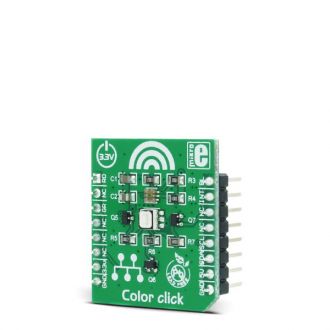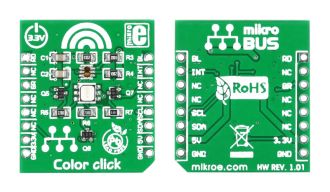
We strongly encourage users to use Package manager for sharing their code on Libstock website, because it boosts your efficiency and leaves the end user with no room for error. [more info]

Rating:
Author: MIKROE
Last Updated: 2018-04-27
Package Version: 1.0.0.1
mikroSDK Library: 1.0.0.0
Category: Optical
Downloaded: 6620 times
Not followed.
License: MIT license
Simple demonstration of using TCS3471 color sensor.
Do you want to subscribe in order to receive notifications regarding "Color click " changes.
Do you want to unsubscribe in order to stop receiving notifications regarding "Color click " changes.
Do you want to report abuse regarding "Color click ".


Library Description
The library initializes and defines the I2C bus driver and drivers that offer a choice for writing data in the register. The library includes a function for configuration chip for measurement, the function reads one color ratio and functions for light color value is received by calculating RGBC value and conversions in HSL value. The user also has the function color_getColor() which checks the color of the light and functions to enable or disable RGB LED.Key functions:
void color_setLED(uint8_t red, uint8_t green, uint8_t blue) - Functions for set Led lightsfloat color_getColorValue() - Functions for reading the color value in HSLuint8_t color_getColor(float color_value) - Functions for detect colorsfloat color_readColorRatio(uint8_t color) - Functions for reading color ratioExample description
The application is composed of three sections :
void applicationTask()
{
colorValue = color_getColorValue();
isColor = color_getColor(colorValue);
switch(isColor)
{
case 1:
{
mikrobus_logWrite("--- Color: ORANGE ", _LOG_LINE);
break;
}
case 2:
{
mikrobus_logWrite("--- Color: RED ", _LOG_LINE);
break;
}
case 3:
{
mikrobus_logWrite("--- Color: PINK ", _LOG_LINE);
break;
}
case 4:
{
mikrobus_logWrite("--- Color: PURPLE ", _LOG_LINE);
break;
}
case 5:
{
mikrobus_logWrite("--- Color: BLUE ", _LOG_LINE);
break;
}
case 6:
{
mikrobus_logWrite("--- Color: CYAN ", _LOG_LINE);
break;
}
case 7:
{
mikrobus_logWrite("--- Color: GREEN ", _LOG_LINE);
break;
}
case 8:
{
mikrobus_logWrite("--- Color: YELLOW ", _LOG_LINE);
break;
}
default:
{
break;
}
}
Delay_100ms();
}
Other MikroElektronika libraries used in the example:
Additional notes and information
Depending on the development board you are using, you may need USB UART click, USB UART 2 click or RS232 click to connect to your PC, for development systems with no UART to USB interface available on the board. The terminal available in all MikroElektronika compilers, or any other terminal application of your choice, can be used to read the message.